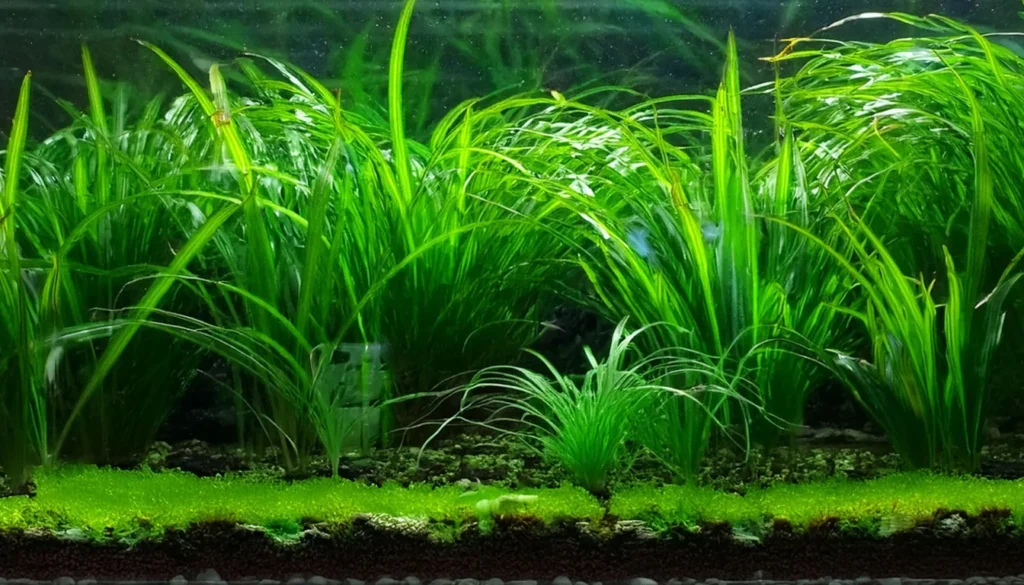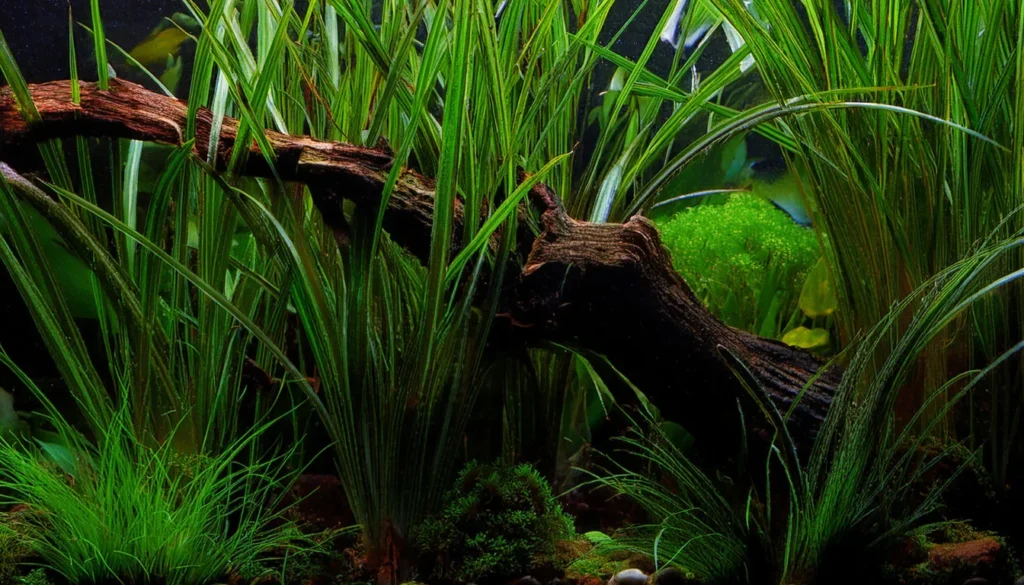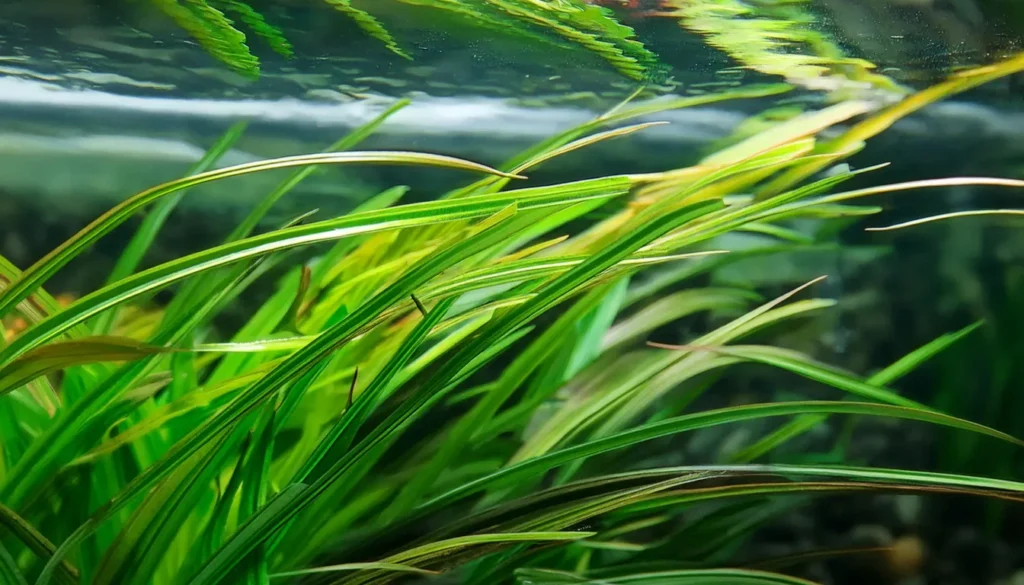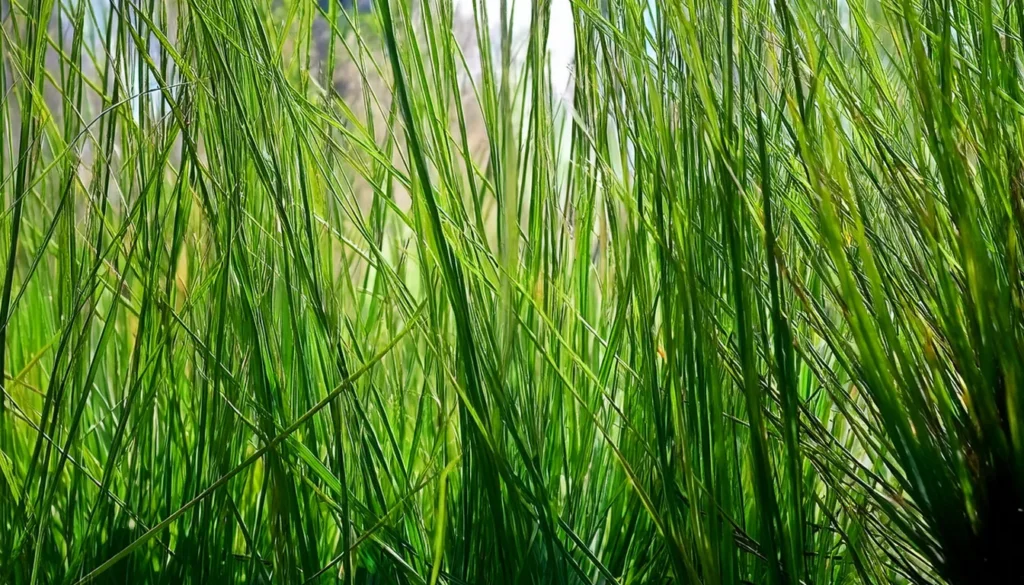Welcome to our comprehensive guide on caring for and growing Vallisneria Nana in your aquarium.
Whether you’re a beginner in the world of aquascaping or a seasoned enthusiast, this guide will provide you with all the essential information you need to ensure the success of your Vallisneria Nana plants.
From understanding their natural habitat and physical characteristics to setting up the perfect tank environment, we’ll cover everything you need to know to keep your Vallisneria Nana thriving.
Key Takeaway
- Understanding the natural habitat and origin of Vallisneria Nana is crucial for recreating suitable conditions.
- Vallisneria Nana has long, narrow leaves and can reach heights of 6-12 inches.
- Provide moderate to high lighting for Vallisneria Nana to ensure healthy growth.
- Maintain a stable temperature within the range of 68-82°F for optimal growth.
- Ensure clean, well-oxygenated water and monitor water parameters regularly.

Quick Stats
| Attribute | Details |
| Scientific Name | Vallisneria nana |
| Common Name | Dwarf Vallisneria, Nana Vallisneria |
| Origin | Cultivated hybrid, precise origin may vary |
| Height | 15-30 cm (6-12 inches) |
| pH Range | 6.5 – 8.0 |
| CO2 Requirement | Low to Medium |
| Growth Rate | Moderate |
| Care Level | Easy |
| Color Form | Green |
| Water Conditions | 18-28°C (64-82°F), adaptable to various water parameters |
| Max Size | Typically remains within the stated height range |
| Lighting | Low to Moderate |
| Supplements | Root tabs or liquid fertilizers beneficial |
| Placement | Midground to Background |
| Propagation | Through runners or division of rhizome |
What Is Vallisneria Nana?
Vallisneria nana, also known as dwarf Vallisneria, is an aquatic plant in the family Hydrocharitaceae.
It is native to Australia and is favored by aquarium enthusiasts for its striking appearance and ease of care.
With its long, narrow leaves and dark green color, Vallisneria nana adds a vibrant and visually appealing touch to any aquarium.
Unlike other Vallisneria species, Vallisneria nana has a smaller size, with heights ranging from 6 to 12 inches (15-30 cm).
This makes it suitable for various aquarium sizes, whether it’s a small tank or a larger aquatic display.
Its versatility allows it to be used as a mid-ground or background plant, providing flexibility in design and arrangement.
Natural Habitat And Origin
Vallisneria nana, commonly known as dwarf Vallisneria, is an aquatic plant native to Australia.
It grows naturally in freshwater ponds and streams and thrives in a wide range of water conditions.
In its natural habitat, Vallisneria nana is typically found in shallow water with moderate to high lighting.
The plant is well-adapted to life in aquatic environments and can withstand varying temperatures and water parameters, making it a hardy and versatile choice for aquarium enthusiasts.
One of the key characteristics of Vallisneria nana’s natural habitat is the formation of dense vegetation.
The plant grows in clusters, providing shelter for aquatic organisms and serving as spawning grounds.
Understanding the natural habitat and origin of Vallisneria nana is crucial for recreating suitable conditions in an aquarium setting, allowing the plant to thrive and contribute to a balanced aquatic ecosystem.

Physical Characteristics
- Vallisneria nana is characterized by its long, narrow leaves that resemble grass blades. The leaves are typically dark green in color and have a slightly rigid texture. They can grow to heights of 6-12 inches (15-30 cm) and can vary in width from 0.2 to 0.4 inches (0.5-1 cm).
- The plant grows from a rhizome, an underground stem producing roots and shoots. Vallisneria nana also produces runners, which are horizontal stems that spread out and give rise to new plants. These runners allow the plant to propagate and form dense stands in an aquarium.
- Understanding Vallisneria nana’s physical characteristics is important for effectively identifying and caring for this plant. Vallisneria nana’s long, narrow leaves and dark green color make it a visually appealing addition to any aquarium. Its slightly rigid texture provides a unique texture contrast when planted alongside other aquatic plants.

Vallisneria Nana Light Requirements
- Vallisneria nana requires moderate to high lighting conditions to thrive. In its natural habitat, it is often found in areas with moderate to high light intensity. In an aquarium setting, providing adequate lighting is crucial for its growth and health.
- LED lights are recommended for this plant due to their energy efficiency and ability to produce the required light intensity. It is important to ensure that the entire plant receives sufficient light, including the lower leaves, by positioning the light source appropriately. Insufficient light can result in stunted growth and poor overall health of Vallisneria nana.

Temperature Parameters
- Vallisneria nana can tolerate a wide range of temperatures, making it suitable for various aquarium setups. The ideal temperature range for this plant is between 68-82°F (20-28°C). It can withstand temperatures as low as 60°F (15°C) and as high as 86°F (30°C) for short periods. However, maintaining a stable temperature within the recommended range is important for the plant’s overall health and growth.
- Fluctuations in temperature can stress the plant and negatively impact its growth and development. Using a reliable aquarium heater and monitoring the water temperature regularly will help ensure the optimal conditions for Vallisneria nana.
Watering Needs Of The Plant
- pH: The recommended pH range for Vallisneria nana is between 6.5 to 8.5. Monitoring and adjusting the pH levels within this range will help ensure optimal growth and health.
- Water Hardness: Vallisneria nana can tolerate a range of water hardness levels. However, to promote healthy growth, it is important to maintain water hardness within acceptable limits.
- Nutrient Levels: Providing Vallisneria nana with a balanced supply of macro and micronutrients is essential for its growth. Incorporating fertilizers rich in these nutrients can support the plant’s development and overall well-being.
Common Challenges In Vallisneria Nana Care
- While caring for Vallisneria nana is generally easy, beginners may encounter some common challenges. One challenge is inadequate lighting, which can lead to slow growth or the development of pale leaves. Proper lighting is crucial for the photosynthesis process and overall health of the plant. To address this challenge, ensure that your aquarium has appropriate lighting with the right intensity for Vallisneria nana. LED lights are recommended for their energy efficiency and ability to provide the required light intensity.
- Another challenge is maintaining sufficient nutrient levels in the water. Insufficient nutrients can result in nutrient deficiencies and hinder the plant’s growth. Regular fertilization is essential to ensure that Vallisneria nana receives the necessary macro and micronutrients. Based on the plant’s requirements, consider using a comprehensive aquarium fertilizer or supplementing it with specific nutrients, such as nitrogen, phosphorus, potassium, iron, manganese, and zinc.
- Algae growth is another common challenge that beginners may face. Algae can compete with Vallisneria nana for nutrients and hinder its growth. To prevent algae growth, ensure that your aquarium is properly balanced and maintain optimal water parameters. Additionally, avoid overstocking your tank with fish, as excess fish waste can contribute to nutrient imbalances and promote algae growth. Regular water changes and maintenance can help control algae growth and maintain a healthy environment for Vallisneria nana.

RELATED: Echinodorus Horemanii Red For A Vibrant Aquarium Plant
Substrate Requirement
- Vallisneria nana requires a nutrient-rich substrate to support its root system and provide essential nutrients. A fine-grained substrate, such as aquarium soil or sand, is recommended for this plant. The substrate should be deep enough to anchor the plant’s roots and allow room for the rhizome to spread.
- Adding root tabs or liquid fertilizers to the substrate can provide additional nutrients for Vallisneria nana’s growth. When planting Vallisneria nana, gently press the roots into the substrate while ensuring that the rhizome is slightly above the substrate surface. This placement allows the plant to receive the necessary nutrients while maintaining stability.
- A properly prepared substrate is essential for Vallisneria nana’s successful growth and development. Ensuring the substrate supports the plant’s nutrient requirements will contribute to its overall health and visual appeal.
Recommended Tank Size
- Vallisneria nana can adapt well to a range of tank sizes, making it suitable for both small and large aquariums. However, it is important to consider the plant’s growth potential and the available space in the tank.
- For smaller aquariums, a tank size of at least 10-20 gallons is recommended to provide ample space for the plant to spread its runners. In larger aquariums, Vallisneria nana can be used as a background plant and will require a tank size of 30 gallons or more. Providing enough space for Vallisneria nana to grow and propagate is essential for maintaining a healthy and visually appealing aquarium.

Suitable Tank Mates
- Guppies: Guppies are peaceful fish that can coexist with this plant.
- Tetras: Neon tetras, cardinal tetras, and other peaceful tetra species can be housed with Vallisneria nana.
- Corydoras catfish: Corydoras catfish are bottom-dwelling and can help keep the substrate clean.
- Shrimp: Ghost, amano, and cherry shrimp are all compatible with Vallisneria nana.
Nutritional Requirements Of The Plants
- Macro Nutrients: like any other plant, this plant requires a balanced supply of macro and micro nutrients to support its growth and development. Macro nutrients are essential for the plant’s overall health and include nitrogen (N), phosphorus (P), and potassium (K). These nutrients are vital in various physiological processes, such as photosynthesis, cell division, and enzyme activities. A deficiency in any of these macronutrients can lead to stunted growth, yellowing of the leaves, and diminished overall health of the plant.
- Micro Nutrients: In addition to macronutrients, this plant also requires micro nutrients for optimal growth. Micronutrients are essential elements that plants need in much smaller quantities but are equally crucial for various biochemical processes. Iron (Fe), manganese (Mn), and zinc (Zn) are examples of micro nutrients that are vital for Vallisneria nana’s growth and development. These micronutrients play essential roles in chlorophyll synthesis, enzyme activation, and electron transfer reactions.
Cultivating Tips
- Provide adequate lighting: This plant requires moderate to high lighting to thrive. Positioning the aquarium lights correctly and ensuring even light distribution will promote healthy growth.
- Maintain optimal water parameters: Regular water testing and maintenance of suitable water parameters, including pH and hardness, are crucial for the plant’s growth and overall health.
- Prune and thin out the plant: Overgrowth and overcrowding can hinder the growth of this plant. Regularly pruning and thinning out the plant will help maintain its shape and promote healthier growth.
- Monitor nutrient levels: Regularly testing the water parameters and monitoring nutrient levels will help ensure that this plant is receiving the necessary nutrients for optimal growth.
- Check for pests and diseases: Regular inspection for pests and diseases is important to identify and treat any issues early on. Trimming affected leaves and using appropriate treatments can help keep the plant healthy.

RELATED: Echinodorus Red Flame To Aesthetically Design Your Aquarium
Propagating Tips
- Wait for the plant to produce runners: This plant naturally generates runners, which are horizontal stems that give rise to new plants. Allow the plant to develop these runners before attempting to propagate it.
- Separate the runners: Once the runners have produced small plantlets, carefully separate them from the parent plant. Gently detach the plantlets from the runner, ensuring that they have their own roots.
- Plant the new plantlets: Place the separated plantlets in the substrate to bury their roots properly. Allow them to establish themselves in their new location.
- Maintain suitable conditions: Provide the newly propagated plantlets with the same care and conditions as the parent plant. This includes providing suitable lighting, maintaining proper water parameters, and ensuring adequate nutrient levels.
Benefits Of Planting Vallisneria Nana
- Oxygenation: This plant releases oxygen through its photosynthesis process, helping to oxygenate the water and create a healthier environment for the fish.
- Water filtration: The dense growth of this plant acts as a natural filter, absorbing excess nutrients and pollutants from the water, thereby improving water quality.
- Aesthetics: this plant adds a natural and aesthetic appeal to the aquarium with its long, slender leaves and vibrant green color. It creates a visually pleasing backdrop or foreground, enhancing the overall beauty of the aquatic display.
- Fish shelter and spawning grounds: The long, dense leaves of this plant provide shelter and hiding places for fish, especially fry and smaller species. They also serve as spawning grounds for fish to lay their eggs.
Conclusion
It is a versatile and easy-to-care-for aquatic plant perfect for beginners.
By understanding its natural habitat, physical characteristics, light requirements, temperature parameters, watering needs, and common care challenges, you can create the ideal conditions for it to thrive in your aquarium.
Remember to consider the proper substrate requirements, recommended tank sizes, and suitable tank mates for this plant.
Additionally, meeting its nutritional requirements and following cultivating and propagating tips will ensure healthy growth and propagation.
Planting Vallisneria nana offers a range of benefits, including oxygenation of the water, natural filtration, aesthetic appeal, and shelter and spawning grounds for fish.
These benefits make this plant a great addition to any aquarium.
By following this comprehensive care guide and utilizing our valuable information, you can cultivate a thriving aquatic display with Vallisneria nana as the focal point.
Frequently Asked Questions
What Are Suitable Tank Mates For Vallisneria Nana?
Some suitable tank mates for Vallisneria nana include peaceful fish species such as guppies, tetras, Corydoras catfish, and certain species of shrimp.
What Are The Nutritional Requirements Of Vallisneria Nana?
To support its growth, this plant requires a balanced supply of macro and micronutrients, including nitrogen, phosphorus, potassium, iron, manganese, and zinc.
What Are Some Cultivating Tips For Vallisneria Nana?
Some cultivating tips for this plant include providing adequate lighting, maintaining optimal water parameters, pruning the plant, and monitoring nutrient levels.
How Can Vallisneria Nana Be Propagated?
This plant can be propagated through its runners. Wait for the plant to produce runners, then separate the new plantlets and plant them in the substrate.
What Are The Benefits Of Planting Vallisneria Nana?
Planting this plant can provide benefits such as oxygenation of the water, natural filtration, aesthetic appeal, and fish shelter and spawning grounds.
- Unveiling The Wonders Of Riccia Fluitans In Aquascapes - August 7, 2024
- Vallisneria Gigantea Var. Guide To Care And Cultivation At Home - July 31, 2024
- Vesicularia Dubyana Care & Growth Guide Tips For Beginner Gardeners - July 30, 2024
